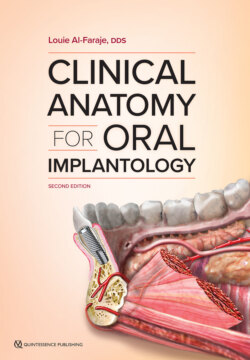Читать книгу Clinical Anatomy for Oral Implantology - Louie Al-Faraje - Страница 14
На сайте Литреса книга снята с продажи.
Surgical importance of the anatomy of the pterygopalatine fossa
ОглавлениеThe anatomy of the pterygopalatine fossa is especially important for the following surgeries:
Vidian neurectomy (the surgical sectioning of the pterygoid nerve for the treatment of vasomotor rhinitis, Sluder’s neuralgia of the pterygopalatine ganglion, crocodile tears syndrome, allergic rhinitis [hay fever], and nasal polyposis)
Transmaxillary ligature of the maxillary artery (in cases of severe nasal bleeding that cannot be controlled by anterior and/or posterior tamponades)
Craniofacial surgery
Surgery of the base of the skull or nasopharynx
Lateral approaches to the orbit
Traumatology
Vasomotor rhinitis is a condition that results from a relative imbalance of parasympathetic to sympathetic stimulation of the blood vessels and glands of the nasal mucosa. It is characterized by symptoms of clear rhinorrhea and nasal congestion.
Sluder’s neuralgia of the pterygopalatine ganglion is a rare disorder characterized by unilateral, severe, burning, boring, or nagging headache, starting around the eye and the bridge of the nose and radiating to the maxilla and maxillary teeth, zygoma, mastoidal area and occiput, or even as far down as the shoulder and arm.
Crocodile tears syndrome (gustatory lacrimation; tearing on eating) is a rare complication of a facial nerve lesion proximal to the geniculate ganglion, whereby regenerating preganglionic salivary fibers intended for the chorda tympani nerve are misdirected to the sphenopalatine ganglion, which project to the lacrimal gland.
